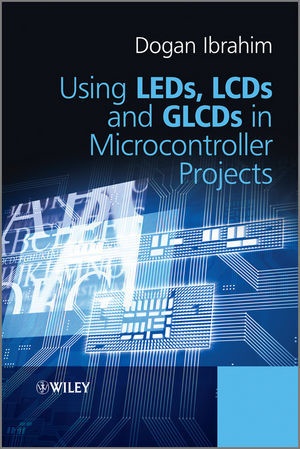Read more
Informationen zum Autor Dogan Ibrahim, Department of Computer Engineering, Near East University,Cyprus Professor Ibrahim is currently Head of the Department of Computer Engineering at Near East University, Cyprus. He has been a lecturer at Near East University since 1999, and prior to this held a range of roles including Principal Research Engineer at GEC Hirst Research Centre, London and Lecturer at South Bank University, London. He is an IEE Fellow. Klappentext Describing the use of displays in microcontroller based projects, the author makes extensive use of real-world, tested projects. The complete details of each project are given, including the full circuit diagram and source code. The author explains how to program microcontrollers (in C language) with LED, LCD and GLCD displays; and gives a brief theory about the operation, advantages and disadvantages of each type of display.Key features:* Covers topics such as: displaying text on LCDs, scrolling text on LCDs, displaying graphics on GLCDs, simple GLCD based games, environmental monitoring using GLCDs (e.g. temperature displays)* Uses C programming throughout the book - the basic principles of programming using C language and introductory information about PIC microcontroller architecture will also be provided* Includes the highly popular PIC series of microcontrollers using the medium range PIC18 family of microcontrollers in the book.* Provides a detailed explanation of Visual GLCD and Visual TFT with examples.* Companion website hosting program listings and data sheets* Contains the extensive use of visual aids for designing LED, LCD and GLCD displays to help readers to understand the details of programming the displays: screen-shots, tables, illustrations, and figures, as well as end of chapter exercisesUsing LEDs, LCDS, and GLCDs in Microcontroller Projects is an application oriented book providing a number of design projects making it practical and accessible for electrical & electronic engineering and computer engineering senior undergraduates and postgraduates. Practising engineers designing microcontroller based devices with LED, LCD or GLCD displays will also find the book of great use. Zusammenfassung Describing the use of displays in microcontroller based projects, the author makes extensive use of real-world, tested projects. The complete details of each project are given, including the full circuit diagram and source code. Inhaltsverzeichnis Preface xiii Acknowledgements xv 1 Introduction to Microcontrollers and Display Systems 1 1.1 Microcontrollers and Microprocessors 2 1.2 Evolution of the Microcontroller 3 1.3 Parts of a Microcontroller 4 1.3.1 Address 4 1.3.2 ALU 5 1.3.3 Analogue Comparator 5 1.3.4 Analogue-to-Digital Converter 5 1.3.5 Brown-out Detector 5 1.3.6 Bus 5 1.3.7 CAN 6 1.3.8 CISC 6 1.3.9 Clock 6 1.3.10 CPU 6 1.3.11 EEPROM 6 1.3.12 EPROM 6 1.3.13 Ethernet 7 1.3.14 Flash Memory 7 1.3.15 Harvard Architecture 7 1.3.16 Idle Mode 7 1.3.17 Interrupts 7 1.3.18 LCD Drivers 8 1.3.19 Pipelining 8 1.3.20 Power-on Reset 8 1.3.21 PROM 8 1.3.22 RAM 8 1.3.23 Real-time Clock 8 1.3.24 Register 9 1.3.25 Reset 9 1.3.26 RISC 9 1.3.27 ROM 9 1.3.28 Serial Input-Output 9 1.3.29 Sleep Mode 9 1.3.30 Supply Voltage 10 1.3.31 Timers 10 1.3.32 USB 10 1.3.33 Watchdog 10 1.4 Display Devices 10 1.4.1 LED 10 1.4.2 7-Segment LED 11 1.4.3 OLED 12 1.4.4 LCD 12 1.5 Summary 15 Exercises 15 2 PIC18F Microcontrollers 17 2.1 The PIC18F2410 Microcontroller 18 2.2 PIC18F2410 Architecture 19 2.2.1 The Program Memory 21 2.2.2 The Data Memory 21 2.2.3 Power Supp...

